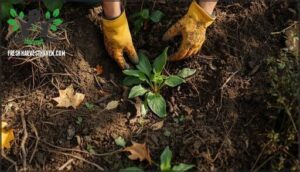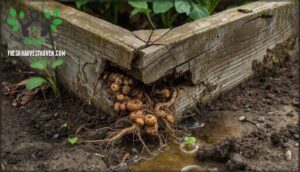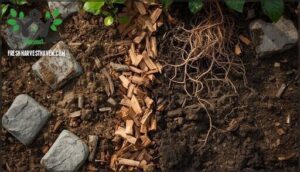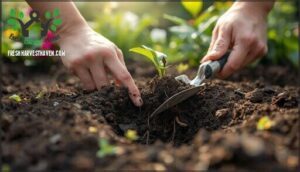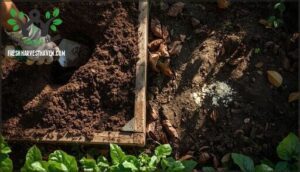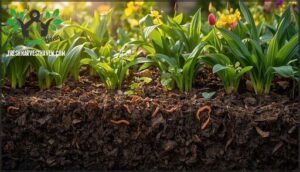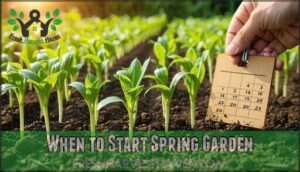This site is supported by our readers. We may earn a commission, at no cost to you, if you purchase through links.
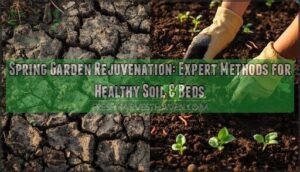
But here’s the liberating truth: you don’t need to accept winter’s damage as inevitable. Strategic spring garden rejuvenation methods—from targeted compost application to cover cropping with field peas—can reverse months of degradation in weeks, restoring your beds to peak performance.
The difference between thriving plants and lackluster growth often comes down to how you prepare the soil when temperatures rise.
Table Of Contents
- Key Takeaways
- Why Spring Garden Rejuvenation Matters
- Clearing and Preparing Garden Beds
- Assessing and Improving Soil Health
- Adding Organic Matter and Amendments
- Sustainable Practices for Spring Rejuvenation
- Frequently Asked Questions (FAQs)
- Do garden beds need to be resurfaced each spring?
- How often should a raised bed be rejuvenated?
- How do I get my Garden ready for spring?
- How do I prepare my garden for the spring equinox?
- Can you cut Hydrangeas in spring?
- How often should garden beds be crop rotated?
- What pests emerge most commonly in spring gardens?
- When is the best time to plant seedlings?
- How do you attract beneficial pollinators early spring?
- Should you fertilize before or after planting seeds?
- Conclusion
Key Takeaways
- Winter wreaks havoc on garden beds through freeze-thaw cycles that shatter soil structure, waterlogging that suffocates beneficial microbes, and nutrient leaching that strips fertility—but strategic spring interventions like targeted compost application and cover cropping can reverse months of degradation in weeks and restore beds to peak performance.
- Annual soil rejuvenation delivers measurable gains including 25–40% increases in nutrient availability, 20–35% improvements in soil porosity for stronger root systems, 10–25% better water retention that cuts irrigation needs, and up to 70% reduction in pathogen incidence through disrupted disease cycles.
- Preventing soil compaction is critical since neglected beds can compact by up to 50%, choking roots and dropping microbial activity by 40%—strategic traffic control, organic amendments, and aeration techniques like broadforking can restore oxygen levels and reduce compaction risk by over 50% without destroying soil structure.
- Sustainable practices like field pea cover cropping add 40–100 kg nitrogen per hectare annually while slashing fertilizer costs by 25%, organic mulching boosts moisture retention by 15–30% while reducing evaporation by 75%, and precision irrigation methods like drip systems and smart controllers cut water usage by 30–50% while improving yields by 15–30%.
Why Spring Garden Rejuvenation Matters
Winter doesn’t just pack up and leave quietly—it leaves your garden beds waterlogged, compacted, and depleted, setting the stage for struggles all season long. A spring refresh breaks that cycle, giving you loose, fertile soil that drains properly and feeds plants exactly what they need.
Here’s what happens when you skip this step, why an annual recharge matters, and the problems you’ll dodge by getting ahead of the game.
Impacts of Winter on Garden Beds
When winter takes its toll on your spring garden, the damage runs deeper than soggy soil. Freeze-thaw cycles shatter soil aggregates, while erosion effects strip away topsoil and expose roots. Nutrient leaching depletes fertility, and microbial decline from repeated freezing weakens the biological engine you need for healthy growth. Winter debris harbors pests and pathogens, and delayed recovery means compacted beds that resist spring cleanup efforts.
Revitalizing raised beds tackles these issues head-on, restoring soil health before planting season kicks off. Gardeners should also consider testing their soil to understand its soil pH balance.
Benefits of Annual Soil Refresh
Your spring soil health reboot delivers measurable wins that compound season after season. Annual compost application and aeration practices release nutrient replenishment, boosting nitrogen, phosphorus, and potassium availability by 25–40%, which directly fuels vigorous growth. You’ll see three major gains:
- Stronger soil structure – Organic matter increases porosity by 20–35%, giving roots room to breathe and expand.
- Better water retention – Compost-enriched beds hold 10–25% more moisture, cutting irrigation needs and drought stress.
- Pest reduction – Soil turnover interrupts disease cycles, slashing pathogen incidence by up to 70%.
These productivity gains keep your beds thriving year after year. Refreshed soil also promotes consistent water absorption.
Common Issues From Neglected Beds
Skip spring entirely, and your beds will push back hard. Neglected soil compacts by up to 50%, choking roots and dropping microbial activity by 40%. Nutrient depletion accelerates—nitrogen and phosphorus can plummet 60% in a year, while weeds multiply at 20% per month, stealing 80% of available nitrogen.
Poor drainage stalls infiltration to 0.1 inch per hour, and earthworm populations crash by 70%, gutting organic matter breakdown and soil health.
Clearing and Preparing Garden Beds
Before you plant a single seed, you need to clear the stage for spring’s performance. Winter leaves behind a mess that can sabotage your growing season if left unchecked.
Here’s how to strip away the old, assess what’s underneath, and stop your soil from disappearing on you.
Removing Winter Debris and Weeds
Think of clearing weeds and debris as reclaiming your spring garden from winter’s grip—this foundational step sets the stage for everything that follows. Once nighttime temperatures stay consistently above 10°C for at least a week, you can start your cleanup without disrupting overwintering pollinators sheltering in plant litter. Here’s your strategic approach:
- Remove dead leaves, stems, and twigs methodically, leaving undisturbed sections to protect beneficial insects that support biological pest control
- Pull weeds when soil moisture is low to prevent compaction, targeting the period before temperatures exceed 15°C when weed emergence peaks
- Exclude diseased or pest-infested material from compost piles, as typical home systems rarely reach the 60°C needed to kill pathogens
- Address salt contamination near pathways by rinsing adjacent areas, reducing soil sodium carryover by 40%
- Shred larger debris before composting to cut decomposition time in half, turning waste into garden gold within one season
Tackling winter weed density early—which can exceed 1,400 plants per square meter—dramatically reduces seed banks and gives your crops the competitive edge they deserve.
Inspecting for Damage or Decay
Why let decay sabotage your growing season before it even starts? Once you’ve cleared winter debris, inspect raised bed frames for wood rot—untreated pine degrades within 2–3 years under moisture above 20%, while frost heaving can push roots upward by 2–5 cm, exposing plants to desiccation.
Check root condition by examining firmness and color; unhealthy, mushy roots signal poor drainage issues or soilborne diseases that slash nutrient uptake by 40–60%. Address standing water lasting beyond 48 hours to prevent pest damage and disease progression, protecting your investment in healthy soil.
Preventing Soil Compaction and Sinking
Protecting soil structure starts with strategic traffic control—confining foot access to designated pathways prevents repeated compression that can slash air permeability by up to 94% and reduce plant growth by 21%. Here’s your defense plan against compaction and sinking:
- Traffic Control: Walk only on stepping stones or boards, never directly on moist soil
- Layering Materials: Install wood chips or cardboard as base layers to maintain porosity and reduce sinking by 30%
- Organic Amendments: Incorporate compost annually to cut bulk density by 9% and boost infiltration over 40%
- Mulch Application: Spread 2–3 inches of organic mulch to distribute pressure during rainfall, preventing surface crusting
- Aeration Methods: Use a broadfork for aerating the soil without inverting layers, restoring oxygen levels within three months
Limiting wet-weather activity slashes long-term compaction risk by more than 50%, preserving the soil aeration your plants desperately need to thrive.
Assessing and Improving Soil Health
Once you’ve cleared your beds, it’s time to get your hands dirty and figure out what’s really going on beneath the surface. Compacted, waterlogged soil won’t give your plants the foundation they need to thrive, so addressing these issues now sets you up for success later.
Here’s how to diagnose problems and fix them before planting season kicks into high gear.
Addressing Soil Compaction and Drainage
Compaction causes more than just a sinking garden bed—heavy traffic and wet soil drive bulk density past root-friendly thresholds, cutting water infiltration up to 70%. Organic matter and aeration tech are your best allies.
Working in 2–4 inches of compost boosts drainage by 60%, while aerating the soil with a broadfork breaks up hardpan without destroying structure.
Improving soil structure means healthier roots, better drainage effects, and soil health that carries through the season.
Enhancing Soil Structure With Perlite
Perlite acts like a shock absorber for compacted soil—its lightweight particles (70–120 kg/m³) wedge open pore spaces, slashing bulk density by 27% and improving soil structure where roots need room to breathe.
Here’s what perlite brings to your beds:
- Perlite soil aeration: Macroporosity jumps 18–25%, delivering oxygen straight to root zones and preventing the anaerobic conditions that stunt growth.
- Perlite water retention: Holds 19–35% of its volume in moisture while maintaining free drainage, cutting irrigation needs by up to 25% in sandy soils.
- Reduce soil compaction: Maintains loose bed structure over repeated watering cycles, keeping infiltration rates above 10 cm/hr.
Perlite pH balance stays neutral (6.5–7.5), so you won’t throw off existing amendments, and crop productivity impacts are real—root biomass increases 18%, translating to stronger plants and better yields.
Adding Organic Matter and Amendments
Once you’ve cleared and tested your soil, it’s time to feed it back to life. The right organic materials and amendments can turn tired dirt into a thriving ecosystem.
Here’s how to layer in the good stuff your beds are craving.
Benefits of Compost and How to Apply It
Think of compost as the best garden multitool—it delivers nitrogen, phosphorus, and potassium while slashing your need for synthetic fertilizers by up to 50%. This simple act of adding compost to beds transforms soil structure, bolsters carbon sequestration, and cuts irrigation demands in half, turning your garden into a self-sustaining powerhouse.
Spread a half-inch to three-inch layer across your beds each spring, working it into the top 8–12 inches of soil to boost water retention by 35–57% and double microbial diversity.
| Compost Benefit | Measurable Impact |
|---|---|
| Water retention | 35–57% increase |
| Nutrient availability | 60% within first year |
| Soil organic carbon | Up to 200% boost |
Application timing matters—early spring or fall integration ensures organic matter breaks down when your soil needs it most, preventing compaction and fueling composting techniques that keep your beds thriving season after season.
Using Leaf Mold, Grass Clippings, and Coffee Grounds
Stacking leaf mold, grass clippings, and coffee grounds into your beds unlocks amendment synergy that transforms compacted soil into a thriving microbial ecosystem. Leaf mold alone boosts tomato yields by 60% and doubles water retention, while grass cycling returns up to 9 kg nitrogen per hectare weekly—resources that would otherwise vanish.
Mix coffee grounds at no more than 20% of your compost volume to avoid nitrogen lockup, and you’ll balance carbon-rich and nitrogen-rich inputs near the ideal 25:1 ratio that accelerates decomposition and slashes synthetic fertilizer dependence by 30–40%.
Amending Soil With Biochar and Minerals
Beyond layering leaf litter and clippings, biochar benefits your beds through unparalleled nutrient retention—magnesium jumps 40%, phosphorus 84%—while slashing nitrogen losses by 35% and locking carbon into soil for years.
Pair biochar with mineral soil amendments like dolomite or urea, and you’ll boost total retention efficiency by 53%, stabilize pH up to 1.2 units, and cut synthetic fertilizer dependence by 20% as enzymes accelerate nutrient cycling.
Sustainable Practices for Spring Rejuvenation
Spring rejuvenation isn’t just about what you add to your soil—it’s about working smarter, not harder. The practices you choose now can slash your water bills, protect your beds from temperature swings, and build fertility that lasts for seasons to come.
Here’s how to rejuvenate your garden while keeping it sustainable, resilient, and ready to thrive.
Cover Cropping With Field Peas
If you’re ready to tap into synthetic fertilizers and unleash your soil’s full potential, field peas as a green manure crop are your secret weapon. These nitrogen-fixing powerhouses deliver measurable benefits:
- Nitrogen fixation: Field peas add 40–100 kg of nitrogen per hectare annually, slashing your fertilizer costs by up to 25% while feeding subsequent crops.
- Soil structure enhancement: Their roots contribute 2 tons of organic matter per hectare, reducing soil compaction by 10–15% and boosting water retention.
- Weed suppression: Dense pea biomass blocks 50–70% of light at the soil surface, cutting weed pressure by up to 60% without herbicides.
Plant cover crops in early spring or late fall, then turn them under before planting.
The economic outcomes speak for themselves—you’ll save $40–$80 per hectare yearly while building soil health that lasts.
Mulching for Moisture and Temperature Control
Mulching is an effective way to keep water where you need it. Organic mulch can boost soil moisture by 15–30% and reduce evaporation by up to 75%. This means you can extend watering breaks by days, not just hours, while also stabilizing soil temperature within a range of 5–9°C daily swings.
| Mulch Type | Moisture Retention | Temperature Effect |
|---|---|---|
| Black polyethylene | Moderate (plastic barrier) | Raises soil +5°C, accelerates growth |
| Organic (straw/compost) | High (15–30% increase) | Cools soil by 10°C, buffers heat |
| Wood chips | Excellent (30% boost) | Stabilizes temps, shields roots |
| White/reflective films | Good (plastic seal) | Reduces heat by 2–4°C vs. black |
Organic mulching options, such as compost, not only improve soil infiltration by 20% but also significantly reduce weeding labor by over 60%. This translates to both time and cost savings for gardeners and landscapers alike.
Implementing Water-Saving Irrigation Methods
After mulching locks in moisture, you can fine-tune your watering strategy with precision tools that slash water usage by 30–50%. Smart controllers adjust schedules based on weather forecasts and soil conditions, cutting outdoor water use by up to 50% compared to manual timers.
Consider these water-saving irrigation methods:
- Drip irrigation delivers water directly to root zones, achieving 90% efficiency versus 50–70% for sprinklers
- Moisture sensors provide real-time data that reduce waste by 40% and boost farm income by 20%
- Rainwater harvesting can save 20–35% of municipal water generally used for irrigation
- System integration combines sensors with automated controls to maintain peak soil moisture between 60–80% field capacity
These watering techniques for gardens don’t just conserve water—they improve yields by 15–30% while protecting your plants from drought stress.
Frequently Asked Questions (FAQs)
Do garden beds need to be resurfaced each spring?
Yes, annual resurfacing is essential. Winter weather and organic decomposition deplete nutrients like nitrogen by 40-80%, reducing soil health and microbial activity.
Regular amending with organic matter restores fertility, prevents compaction, and reduces pest susceptibility in your garden beds.
How often should a raised bed be rejuvenated?
Rejuvenation frequency depends on your cropping intensity and climate, but annual soil refresh in spring or fall keeps raised beds thriving. Organic loss occurs at 3-6% yearly, so replenishing raised bed soil with compost prevents degradation and delivers rejuvenation benefits like 20-30% better yields.
How do I get my Garden ready for spring?
Start your spring garden bed preparation by clearing winter debris, pulling weeds, and testing your soil for nutrient deficiencies.
Add compost sourcing from quality suppliers, refresh mulch layers to regulate temperature, and complete your irrigation setup before planting seeds and seedlings into healthy, amended soil.
How do I prepare my garden for the spring equinox?
Preparing your garden for the spring equinox starts with clearing debris and testing your soil health—this reveals nutrient gaps and pH levels that guide your compost applications and frost protection tips.
As soil thawing begins, add organic matter to improve drainage, then follow an equinox planting guide and seed starting timeline for early bloom strategies.
Can you cut Hydrangeas in spring?
Pruning hydrangeas in spring depends on bloom type. Those flowering on old wood risk losing buds if cut too late, while new wood bloomers tolerate spring pruning better, promoting healthy growth without sacrificing flowers.
How often should garden beds be crop rotated?
Rotating your crops every three to four years isn’t just smart—it’s the difference between thriving beds and pest-riddled disasters. This rotation frequency slashes pest reduction rates by up to 60%, resets nutrient balance, and when you include legumes, boosts soil nitrogen by 20-40%, fundamentally transforming soil health and plant vitality for sustainable gardening success.
What pests emerge most commonly in spring gardens?
Aphids appear first, reproducing through 12 generations per season, while slug activity peaks in damp conditions—gardens harbor over 20,000 slugs, though only 5% surface visibly.
Japanese beetles and leaf miners follow in late spring, causing rapid pest damage without early organic pest control interventions.
When is the best time to plant seedlings?
Cool-season crops tolerate spring planting two to four weeks before your last frost date, while warm-season seedlings need soil temperatures above 50°F and regional climate data confirming late frosts have passed—usually two to three weeks after that final freeze.
How do you attract beneficial pollinators early spring?
Plant native bloomers like bloodroot and spicebush to draw in early pollinators. Add shallow water sources with rocks, and install bee hotels or leave leaf litter for nesting sites.
Skip pesticides—they devastate spring pollination. Floral diversity fuels ecosystem freedom.
Should you fertilize before or after planting seeds?
Fertilization strategies depend on crop-specific needs and soil fertility. Applying organic fertilizers before planting improves nutrient levels gradually without osmotic stress risk.
Post-planting feeds boost seedling vigor and germination success rates once roots establish, preventing nutrient deficiency.
Conclusion
Your soil has endured an absolute onslaught—but it’s not beyond rescue. The spring garden rejuvenation methods you’ve implemented today won’t just patch over winter’s damage; they’ll architect a thriving underground ecosystem where roots spread freely and microbes multiply.
You’ve turned compacted, lifeless beds into fertile ground that rewards every seed you plant. This isn’t maintenance—it’s reclaiming control over the growing season ahead, ensuring your garden answers to you, not to last season’s neglect.

